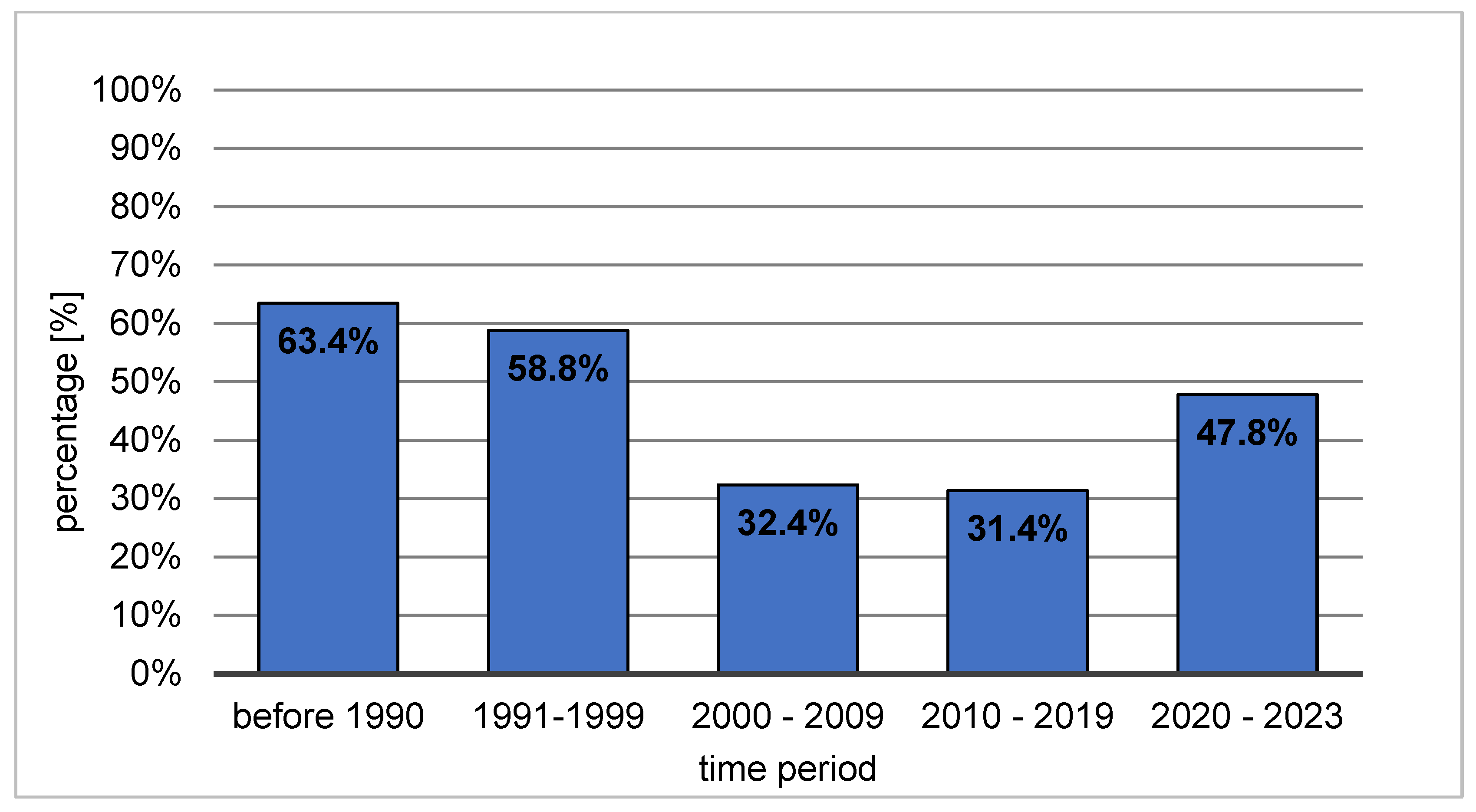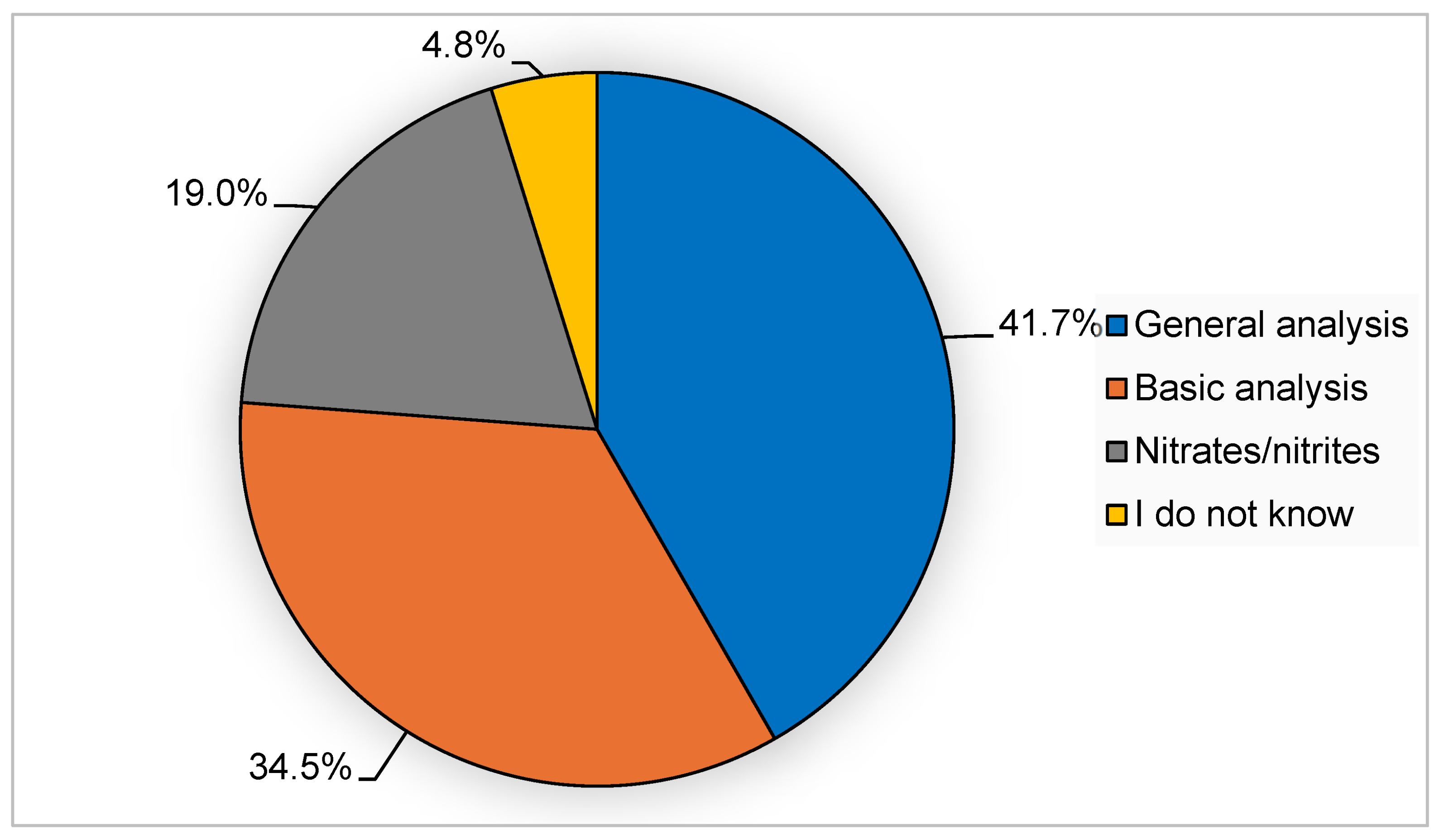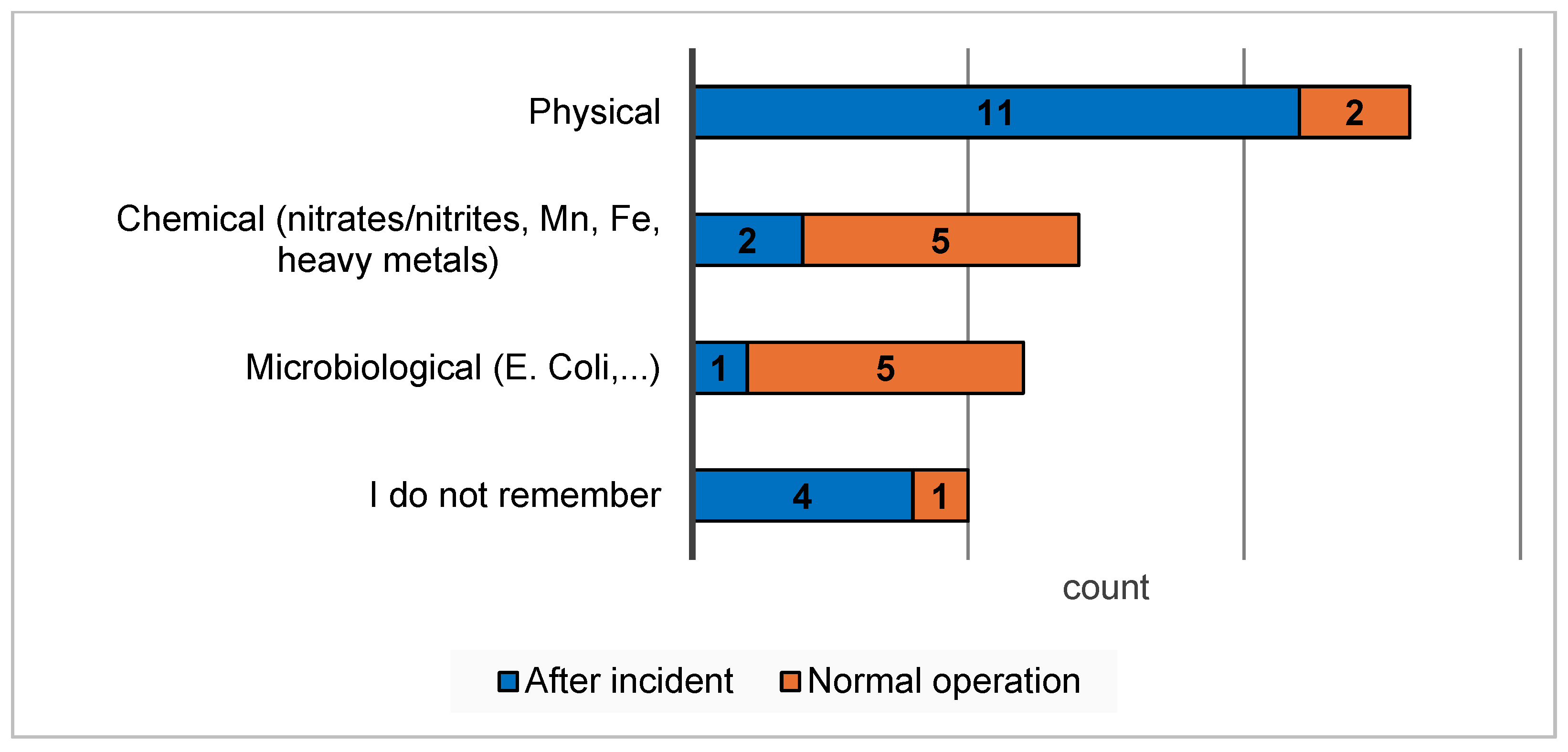A Call for Action: Improving Individual Well Management in Slovakia
Abstract
1. Introduction
2. Materials and Methods
2.1. Questionnaire
2.2. Data Collection
2.3. Data Analysis
3. Results
3.1. Characteristics of the Participants
3.2. Properties of Individual Wells in Surveyed Households
3.3. Drinking of Well Water
4. Discussion
5. Conclusions
Supplementary Materials
Author Contributions
Funding
Data Availability Statement
Acknowledgments
Conflicts of Interest
Abbreviations
| WWD | World Water Day |
References
- Hulsmann, A. Small Systems Large Problems: A European inventory of Small Water Systems and Associated Problems. WeKnow (Web-based European Knowledge Network on Water)/Endware Report 2005, 1. Available online: https://www.oieau.fr/eaudoc/system/files/documents/41/208128/208128_doc.pdf (accessed on 3 June 2025).
- Colley, S.K.; Kane, P.K.; MacDonald Gibson, J. Risk communication and factors influencing private well testing behavior: A systematic scoping review. Int. J. Environ. Res. Public Health 2019, 16, 4333. [Google Scholar] [CrossRef] [PubMed]
- Directive (EU) 2020/2184 of the European Parliament and of the Council of 16 December 2020 on the quality of water intended for human consumption. Off. J. Eur. Union 2020, L435, 1–62.
- Decree of the Ministry of Health of the Slovak Republic No. 91/2023 Coll., establishing indicators and limit values for drinking water quality and hot water quality, the procedure for monitoring drinking water, risk management of drinking water supply systems, and risk management of domestic distribution systems. In Zbierka zákonov SR; Ministry of Justice of the Slovak Republic: Bratislava, Slovakia, 2023. (In Slovak)
- Act No. 25/2025 Coll., the Building Act, amending and supplementing certain acts (Building Act). In Zbierka zákonov SR; Ministry of Justice of the Slovak Republic: Bratislava, Slovakia, 2025. (In Slovak)
- Valovičová, Z.; Michalková, K.; Gubková, D. Zdravá Pitná Voda z Vlastnej Studne; National Reference Centre for Drinking Water: Bratislava, Slovakia, 2017. [Google Scholar]
- Tchounwou, P.B.; Yedjou, C.G.; Patlolla, A.K.; Sutton, D.J. Heavy Metal Toxicity and the Environment. In Molecular, Clinical and Environmental Toxicology; Luch, A., Ed.; Experientia Supplementum; Springer: Basel, Switzerland, 2012; Volume 101. [Google Scholar] [CrossRef]
- Dotherow, J.E.; Apenteng, B.; Hansen, A.; Aslan, A. Private well water stewardship in rural Georgia. PLoS ONE 2024, 19, e0307281. [Google Scholar] [CrossRef] [PubMed]
- Flanagan, S.V.; Spayd, S.E.; Procopio, N.A.; Chillrud, S.N.; Ross, J.; Braman, S.; Zheng, Y. Arsenic in private well water part 2 of 3: Who benefits the most from traditional testing promotion? Sci. Total Environ. 2016, 562, 1010–1018. [Google Scholar] [CrossRef]
- Fox, M.A.; Nachman, K.E.; Anderson, B.; Lam, J.; Resnick, B. Meeting the public health challenge of protecting private wells: Proceedings and recommendations from an expert panel workshop. Sci. Total Environ. 2016, 554, 113–118. [Google Scholar] [CrossRef]
- Hexemer, A.M.; Pintar, K.; Bird, T.M.; Zentner, S.E.; Garcia, H.P.; Pollari, F. An investigation of bacteriological and chemical water quality and the barriers to private well water sampling in a Southwestern Ontario Community. J. Water Health 2008, 6, 521–525. [Google Scholar] [CrossRef]
- Hynds, P.D.; Misstear, B.D.; Gill, L.W. Unregulated private wells in the Republic of Ireland: Consumer awareness, source susceptibility and protective actions. J. Environ. Manag. 2013, 127, 278–288. [Google Scholar] [CrossRef]
- Charrois, J.W. Private drinking water supplies: Challenges for public health. CMAJ 2010, 182, 1061–1064. [Google Scholar] [CrossRef]
- Imgrund, K.; Kreutzwiser, R.; De Loë, R. Influences on the water testing behaviors of private well owners. J. Water Health 2011, 9, 241–252. [Google Scholar] [CrossRef]
- Jones, A.Q.; Dewey, C.E.; Doré, K.; Majowicz, S.E.; McEwen, S.A.; David, W.T.; Henson, S.J. Public perceptions of drinking water: A postal survey of residents with private water supplies. BMC Public Health 2006, 6, 94. [Google Scholar] [CrossRef]
- Kreutzwiser, R.; De Loë, R.; Imgrund, K.; Conboy, M.J.; Simpson, H.; Plummer, R. Understanding stewardship behaviour: Factors facilitating and constraining private water well stewardship. J. Environ. Manag. 2011, 92, 1104–1114. [Google Scholar] [CrossRef]
- Lavallee, S.; Latchmore, T.; Egan, R.; Hynds, P.D.; Brown, R.S.; Majury, A. ‘If it works, don’t fix it’: A qualitative study of knowledge, perception, and behaviour among private well owners in southeastern Ontario. Groundw. Sustain. Dev. 2024, 24, 101057. [Google Scholar] [CrossRef]
- Malecki, K.M.; Schultz, A.A.; Severtson, D.J.; Anderson, H.A.; VanDerslice, J.A. Private-well stewardship among a general population based sample of private well-owners. Sci. Total Environ. 2017, 601, 1533–1543. [Google Scholar] [CrossRef] [PubMed]
- Mulhern, R.; Grubbs, B.; Gray, K.; Gibson, J.M. User experience of point-of-use water treatment for private wells in North Carolina: Implications for outreach and well stewardship. Sci. Total Environ. 2022, 806, 150448. [Google Scholar] [CrossRef]
- Regional Public Health Authority with its Seat in Čadca. Annual Report on the Activity of the Regional Public Health Authority with its Seat in Čadca in 2023; Regional Public Health Authority with its Seat in Čadca: Čadca, Slovakia, 2023. [Google Scholar]
- Regional Public Health Authority with its Seat in Spišská Nová Ves. Annual Report on the Activity of the Regional Public Health Authority with its Seat in Spišská Nová Ves in 2022; Regional Public Health Authority with its Seat in Spišská Nová Ves: Spišská Nová Ves, Slovakia, 2022. [Google Scholar]
- Munene, A.; Hall, D.C. Factors influencing perceptions of private water quality in North America: A systematic review. Syst. Rev. 2019, 8, 111. [Google Scholar] [CrossRef]
- Filčák, R.; Škobla, D. Sanitation Infrastructure at the Systemic Edge: Segregated Roma Settlements and Multiple Health Risks in Slovakia. Int. J. Environ. Res. Public Health 2021, 18, 6079. [Google Scholar] [CrossRef] [PubMed]
- Marcin, D.; Benková, K. Regional Hydrogeological Characteristics of Mineral Water Aquifers in Slovakia. Slovak Geol. Mag. 2016, 16, 123–145. [Google Scholar]
- Van der Wal, A. Understanding Groundwater and Wells in Manual Drilling; PRACTICA Foundation: Papendrecht, The Netherlands, 2010. [Google Scholar]
- Regulatory Office for Network Industries. Annual Report 2023; Regulatory Office for Network Industries: Bratislava, Slovakia, 2024. (In Slovak)
- Maran, N.H.; Crispim, B.D.A.; Iahnn, S.R.; Araújo, R.P.d.; Grisolia, A.B.; Oliveira, K.M.P.d. Depth and Well Type Related to Groundwater Microbiological Contamination. Int. J. Environ. Res. Public Health 2016, 13, 1036. [Google Scholar] [CrossRef]
- Piršelová, B.; Milecová, K.; Kuna, R.; Hegedúšová, A. Monitoring výskytu vybraných rizikových prvkov v pitnej vode regiónu Rimavská Sobota. Acta Fac. Ecol. 2010, 23, 55–58. (In Slovak) [Google Scholar]
- Rozin, P. Food choice: An introduction. Understanding Consumers of Food Products; Woodhead Publishing: Cambridge, UK, 2007; pp. 3–29. [Google Scholar]
- Schuitema, G.; Hooks, T.; McDermott, F. Water quality perceptions and private well management: The role of perceived risks, worry and control. J. Environ. Manag. 2020, 267, 110654. [Google Scholar] [CrossRef]
- Sousa, A.; Taveira, M.; Silva, L. Groundwater from private drinking water wells: Imminent public health issue. Water Resour. 2015, 42, 517–524. [Google Scholar] [CrossRef]
- Sovičová, M.; Baška, T.; Kuka, S.; Tatarková, M.; Štefanová, E.; Marušiaková, M.; Hudečková, H. Private wells as potential sources of heavy metal exposure: A pilot study in northwest Slovakia. Cent. Eur. J. Public Health 2021, 29, 265–270. [Google Scholar] [CrossRef] [PubMed]
- Stillo, F., III; de Bruin, W.B.; Zimmer, C.; Gibson, J.M. Well water testing in African-American communities without municipal infrastructure: Beliefs driving decisions. Sci. Total Environ. 2019, 686, 1220–1228. [Google Scholar] [CrossRef] [PubMed]
- Straub, C.L.; Leahy, J.E. Application of a modified health belief model to the pro-environmental behavior of private well water testing. JAWRA J. Am. Water Resour. Assoc. 2014, 50, 1515–1526. [Google Scholar] [CrossRef]




| Characteristics | Categories | No. 1 | Percentage (%) |
|---|---|---|---|
| District | Spišská Nová Ves | 50 | 19.9% |
| Čadca | 36 | 14.3% | |
| Žilina | 24 | 9.6% | |
| Martin | 18 | 7.2% | |
| Gelnica | 12 | 4.8% | |
| Bardejov | 12 | 4.8% | |
| Other 46 districts (<10 respondents) | 99 | 39.4% | |
| Gender | Men | 124 | 49.4% |
| Women | 127 | 50.6% | |
| Age | To 29 years | 28 | 11.2% |
| 30−49 years | 87 | 34.7% | |
| 50−64 years | 79 | 31.5% | |
| 65 years and more | 57 | 22.7% | |
| Education | Primary | 2 | 0.8% |
| Secondary | 44 | 17.5% | |
| Upper secondary with a school leaving certificate | 94 | 37.5% | |
| University education | 111 | 44.2% |
| Characteristics | Categories | No. 1 | Percentage (%) |
|---|---|---|---|
| Well exploitation | Before 1990 | 93 | 37.1% |
| 1991–1999 | 17 | 6.8% | |
| 2000–2009 | 34 | 13.5% | |
| 2010–2019 | 51 | 20.3% | |
| 2020–2023 | 46 | 18.3% | |
| No data | 10 | 4.0% | |
| Type of well | Dug | 125 | 49.8% |
| Drilled | 126 | 50.2% | |
| Source of pollution | Sump, septic tank, pipes, sewage connections | 37 | 14.7% |
| Barn, urine pits, manure pits | 20 | 8.0% | |
| Road, road ditch | 48 | 19.1% | |
| Stream, river, surface flow | 51 | 20.3% | |
| No source of pollution | 132 | 52.6% | |
| Usage | Drinking | 122 | 48.6% |
| Personal hygiene | 154 | 61.4% | |
| Watering | 210 | 83.7% | |
| Technical use (filling up the poll/hot tube, laundry washing, etc.) | 135 | 53.8% | |
| Frequency of technical inspection | Several times a year | 103 | 41.0% |
| Yearly | 61 | 24.3% | |
| Every few years | 43 | 17.1% | |
| I do not remember. | 19 | 7.6% | |
| Never | 18 | 7.2% | |
| After incident/extreme weather event only | 7 | 2.8% |
| Variable | Drinking | p Value | |||
|---|---|---|---|---|---|
| No 1 (%) | Yes (%) | Total (%) | |||
| 129 (51.4%) | 122 (48.6%) | 251 (100.0%) | |||
| Type of well | dug | 57 (44.2%) | 68 (55.7%) | 125 (49.8%) | NS 2 |
| drilled | 72 (55.8%) | 54 (44.3%) | 126 (50.2%) | ||
| Well water treatment system | 21 (16.3%) | 45 (36.9%) | 66 (26.3%) | p < 0.05 | |
| Regular technical inspection (2–4 times per year) | 48 (37.2%) | 55 (45.1%) | 103 (41.0%) | NS | |
| Those who ever tested their well water quality | 59 (45.7%) | 84 (68.9%) | 143 (57.0%) | p < 0.05 | |
| Well water testing according to recommendations (at least once a year) | 22 (17.1%) | 27 (22.1%) | 49 (19.5%) | NS | |
Disclaimer/Publisher’s Note: The statements, opinions and data contained in all publications are solely those of the individual author(s) and contributor(s) and not of MDPI and/or the editor(s). MDPI and/or the editor(s) disclaim responsibility for any injury to people or property resulting from any ideas, methods, instructions or products referred to in the content. |
© 2025 by the authors. Licensee MDPI, Basel, Switzerland. This article is an open access article distributed under the terms and conditions of the Creative Commons Attribution (CC BY) license (https://creativecommons.org/licenses/by/4.0/).
Share and Cite
Sovičová, M.; Baška, T.; Zibolenová, J.; Hudečková, H.; Tatarková, M.; Eštóková, M.; Valovičová, Z.; Záborský, T.; Marušiaková, M. A Call for Action: Improving Individual Well Management in Slovakia. Water 2025, 17, 1733. https://doi.org/10.3390/w17121733
Sovičová M, Baška T, Zibolenová J, Hudečková H, Tatarková M, Eštóková M, Valovičová Z, Záborský T, Marušiaková M. A Call for Action: Improving Individual Well Management in Slovakia. Water. 2025; 17(12):1733. https://doi.org/10.3390/w17121733
Chicago/Turabian StyleSovičová, Miroslava, Tibor Baška, Jana Zibolenová, Henrieta Hudečková, Mária Tatarková, Milada Eštóková, Zuzana Valovičová, Tibor Záborský, and Mária Marušiaková. 2025. "A Call for Action: Improving Individual Well Management in Slovakia" Water 17, no. 12: 1733. https://doi.org/10.3390/w17121733
APA StyleSovičová, M., Baška, T., Zibolenová, J., Hudečková, H., Tatarková, M., Eštóková, M., Valovičová, Z., Záborský, T., & Marušiaková, M. (2025). A Call for Action: Improving Individual Well Management in Slovakia. Water, 17(12), 1733. https://doi.org/10.3390/w17121733






